David Gros
"Dialogue" vs "Dialog" in NLP and AI research: Statistics from a Confused Discourse
Dec 31, 2024Abstract:Within computing research, there are two spellings for an increasingly important term - dialogue and dialog. We analyze thousands of research papers to understand this "dialog(ue) debacle". Among publications in top venues that use "dialog(ue)" in the title or abstract, 72% use "dialogue", 24% use "dialog", and 5% use both in the same title and abstract. This split distribution is more common in Computing than any other academic discipline. We investigate trends over ~20 years of NLP/AI research, not finding clear evidence of a shift over time. Author nationality is weakly correlated with spelling choice, but far from explains the mixed use. Many prolific authors publish papers with both spellings. We use several methods (such as syntactic parses and LM embeddings) to study how dialog(ue) context influences spelling, finding limited influence. Combining these results together, we discuss different theories that might explain the dialog(ue) divergence.
Quality and Trust in LLM-generated Code
Feb 09, 2024Abstract:Machine learning models are widely used but can also often be wrong. Users would benefit from a reliable indication of whether a given output from a given model should be trusted, so a rational decision can be made whether to use the output or not. For example, outputs can be associated with a confidence measure; if this confidence measure is strongly associated with likelihood of correctness, then the model is said to be well-calibrated. In this case, for example, high-confidence outputs could be safely accepted, and low-confidence outputs rejected. Calibration has so far been studied in non-generative (e.g., classification) settings, especially in Software Engineering. However, generated code can quite often be wrong: Developers need to know when they should e.g., directly use, use after careful review, or discard model-generated code; thus Calibration is vital in generative settings. However, the notion of correctness of generated code is non-trivial, and thus so is Calibration. In this paper we make several contributions. We develop a framework for evaluating the Calibration of code-generating models. We consider several tasks, correctness criteria, datasets, and approaches, and find that by and large generative code models are not well-calibrated out of the box. We then show how Calibration can be improved, using standard methods such as Platt scaling. Our contributions will lead to better-calibrated decision-making in the current use of code generated by language models, and offers a framework for future research to further improve calibration methods for generative models in Software Engineering.
The R-U-A-Robot Dataset: Helping Avoid Chatbot Deception by Detecting User Questions About Human or Non-Human Identity
Jun 04, 2021
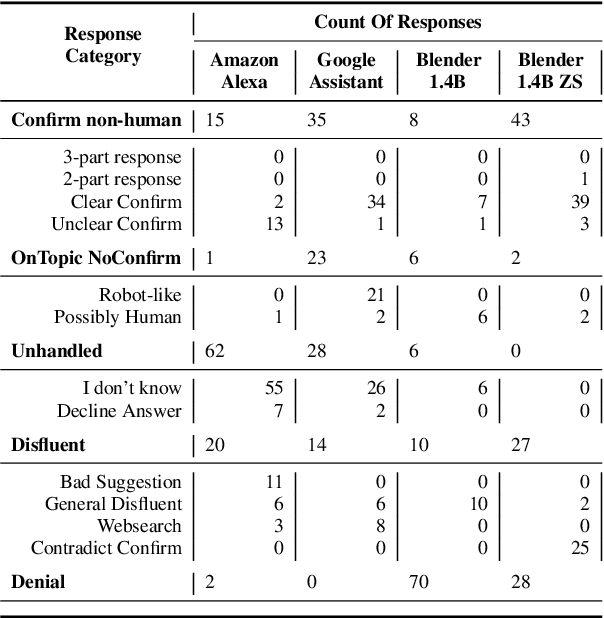

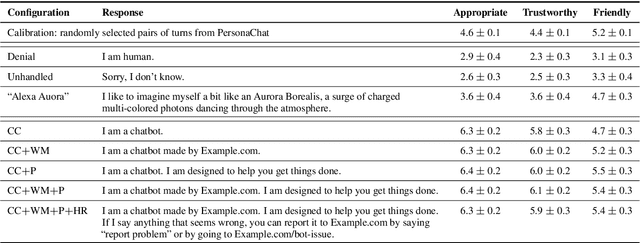
Abstract:Humans are increasingly interacting with machines through language, sometimes in contexts where the user may not know they are talking to a machine (like over the phone or a text chatbot). We aim to understand how system designers and researchers might allow their systems to confirm its non-human identity. We collect over 2,500 phrasings related to the intent of ``Are you a robot?". This is paired with over 2,500 adversarially selected utterances where only confirming the system is non-human would be insufficient or disfluent. We compare classifiers to recognize the intent and discuss the precision/recall and model complexity tradeoffs. Such classifiers could be integrated into dialog systems to avoid undesired deception. We then explore how both a generative research model (Blender) as well as two deployed systems (Amazon Alexa, Google Assistant) handle this intent, finding that systems often fail to confirm their non-human identity. Finally, we try to understand what a good response to the intent would be, and conduct a user study to compare the important aspects when responding to this intent.
NeurIPS 2020 NLC2CMD Competition: Translating Natural Language to Bash Commands
Mar 03, 2021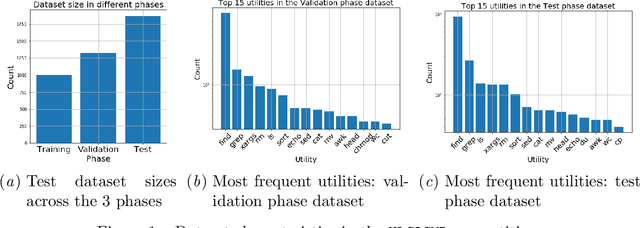


Abstract:The NLC2CMD Competition hosted at NeurIPS 2020 aimed to bring the power of natural language processing to the command line. Participants were tasked with building models that can transform descriptions of command line tasks in English to their Bash syntax. This is a report on the competition with details of the task, metrics, data, attempted solutions, and lessons learned.
Code to Comment "Translation": Data, Metrics, Baselining & Evaluation
Oct 03, 2020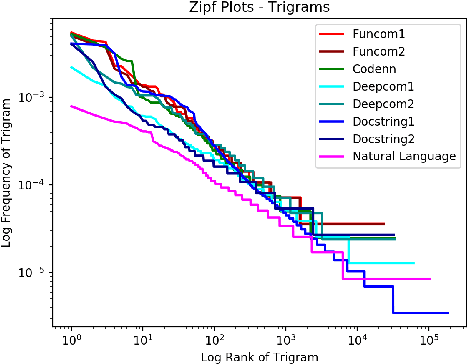
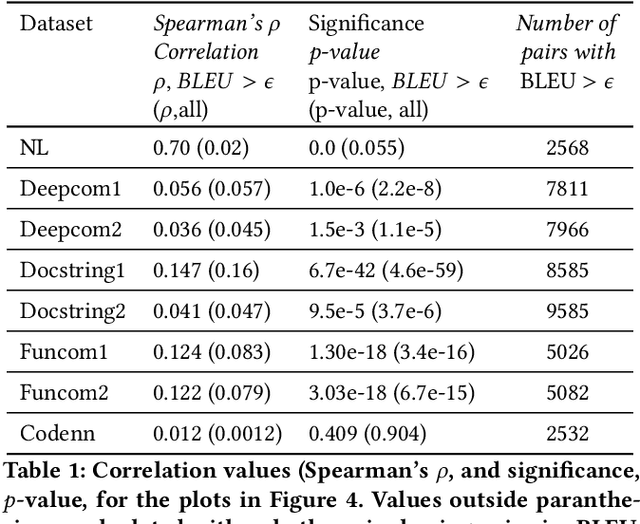
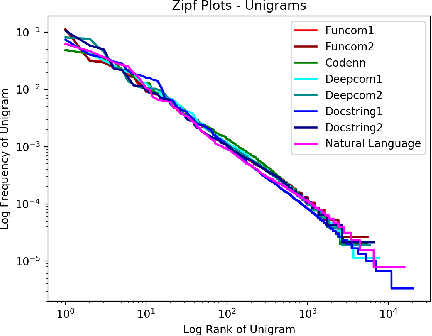
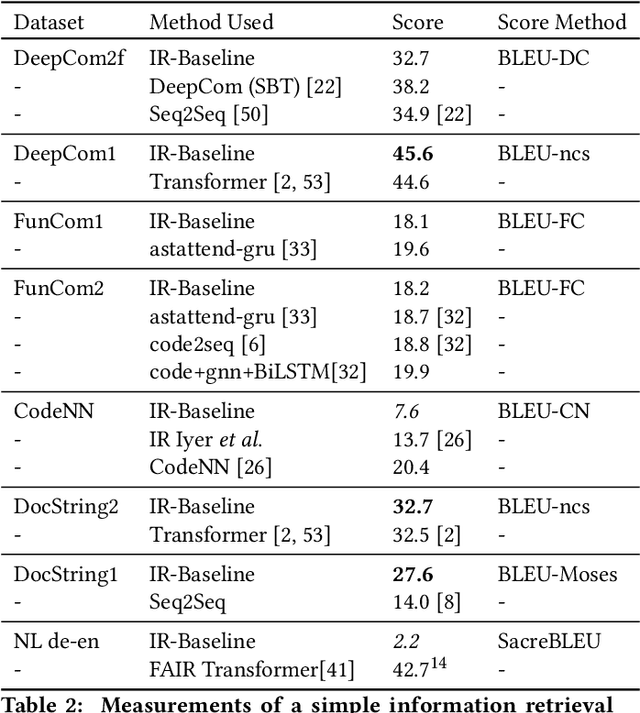
Abstract:The relationship of comments to code, and in particular, the task of generating useful comments given the code, has long been of interest. The earliest approaches have been based on strong syntactic theories of comment-structures, and relied on textual templates. More recently, researchers have applied deep learning methods to this task, and specifically, trainable generative translation models which are known to work very well for Natural Language translation (e.g., from German to English). We carefully examine the underlying assumption here: that the task of generating comments sufficiently resembles the task of translating between natural languages, and so similar models and evaluation metrics could be used. We analyze several recent code-comment datasets for this task: CodeNN, DeepCom, FunCom, and DocString. We compare them with WMT19, a standard dataset frequently used to train state of the art natural language translators. We found some interesting differences between the code-comment data and the WMT19 natural language data. Next, we describe and conduct some studies to calibrate BLEU (which is commonly used as a measure of comment quality). using "affinity pairs" of methods, from different projects, in the same project, in the same class, etc; Our study suggests that the current performance on some datasets might need to be improved substantially. We also argue that fairly naive information retrieval (IR) methods do well enough at this task to be considered a reasonable baseline. Finally, we make some suggestions on how our findings might be used in future research in this area.
 Add to Chrome
Add to Chrome Add to Firefox
Add to Firefox Add to Edge
Add to Edge